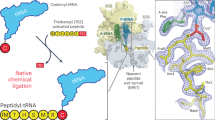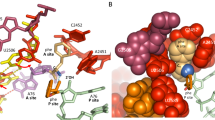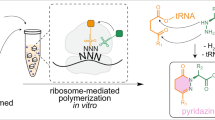Abstract
The chemical step of natural protein synthesis, peptide bond formation, is catalysed by the large subunit of the ribosome. Crystal structures have shown that the active site for peptide bond formation is composed entirely of RNA1. Recent work has focused on how an RNA active site is able to catalyse this fundamental biological reaction at a suitable rate for protein synthesis. On the basis of the absence of important ribosomal functional groups2 , lack of a dependence on pH3, and the dominant contribution of entropy to catalysis4, it has been suggested that the role of the ribosome is limited to bringing the substrates into close proximity. Alternatively, the importance of the 2′-hydroxyl of the peptidyl-transfer RNA5 and a Brønsted coefficient near zero6 have been taken as evidence that the ribosome coordinates a proton-transfer network. Here we report the transition state of peptide bond formation, based on analysis of the kinetic isotope effect at five positions within the reaction centre of a peptidyl-transfer RNA mimic. Our results indicate that in contrast to the uncatalysed reaction, formation of the tetrahedral intermediate and proton transfer from the nucleophilic nitrogen both occur in the rate-limiting step. Unlike in previous proposals, the reaction is not fully concerted; instead, breakdown of the tetrahedral intermediate occurs in a separate fast step. This suggests that in addition to substrate positioning, the ribosome is contributing to chemical catalysis by changing the rate-limiting transition state.
This is a preview of subscription content, access via your institution
Access options
Subscribe to this journal
Receive 51 print issues and online access
$199.00 per year
only $3.90 per issue
Buy this article
- Purchase on Springer Link
- Instant access to full article PDF
Prices may be subject to local taxes which are calculated during checkout




Similar content being viewed by others
References
Nissen, P., Hansen, J., Ban, N., Moore, P. B. & Steitz, T. A. The structural basis of ribosome activity in peptide bond synthesis. Science 289, 920–930 (2000)
Erlacher, M. D. et al. Chemical engineering of the peptidyl transferase center reveals an important role of the 2′-hydroxyl group of A2451. Nucleic Acids Res. 33, 1618–1627 (2005)
Bieling, P., Beringer, M., Adio, S. & Rodnina, M. V. Peptide bond formation does not involve acid-base catalysis by ribosomal residues. Nature Struct. Mol. Biol. 13, 423–428 (2006)
Sievers, A., Beringer, M., Rodnina, M. V. & Wolfenden, R. The ribosome as an entropy trap. Proc. Natl Acad. Sci. USA 101, 7897–7901 (2004)
Zaher, H. S., Shaw, J. J., Strobel, S. A. & Green, R. The 2′-OH group of the peptidyl-tRNA stabilizes an active conformation of the ribosomal PTC. EMBO J. 30, 2445–2453 (2011)
Kingery, D. A. et al. An uncharged amine in the transition state of the ribosomal peptidyl transfer reaction. Chem. Biol. 15, 493–500 (2008)
Satterthwait, A. C. & Jencks, W. P. Mechanism of the aminolysis of acetate esters. J. Am. Chem. Soc. 96, 7018–7031 (1974)
Dorner, S., Panuschka, C., Schmid, W. & Barta, A. Mononucleotide derivatives as ribosomal P-site substrates reveal an important contribution of the 2′-OH to activity. Nucleic Acids Res. 31, 6536–6542 (2003)
Schmeing, T. M., Huang, K. S., Kitchen, D. E., Strobel, S. A. & Steitz, T. A. Structural insights into the roles of water and the 2′ hydroxyl of the P site tRNA in the peptidyl transferase reaction. Mol. Cell 20, 437–448 (2005)
Wallin, G. & Åqvist, J. The transition state for peptide bond formation reveals the ribosome as a water trap. Proc. Natl Acad. Sci. USA 107, 1888–1893 (2010)
Wang, Q., Gao, J., Liu, Y. & Liu, C. Validating a new proton shuttle reaction pathway for formation of the peptide bond in ribosomes: a theoretical investigation. Chem. Phys. Lett. 501, 113–117 (2010)
Rangelov, M. A., Petrova, G. P., Yomtova, V. M. & Vayssilov, G. N. Catalytic role of vicinal OH in ester aminolysis: proton shuttle versus hydrogen bond stabilization. J. Org. Chem. 75, 6782–6792 (2010)
Huang, K. S., Carrasco, N., Pfund, E. & Strobel, S. A. Transition state chirality and role of the vicinal hydroxyl in the ribosomal peptidyl transferase reaction. Biochemistry 47, 8822–8827 (2008)
Cleland, W. W. Isotope effects: determination of enzyme transition state structure. Enzyme Kinetics Mech. D 249, 341–373 (1995)
Zhong, M. & Strobel, S. A. Synthesis of the ribosomal P-site substrate CCA-pcb. Org. Lett. 8, 55–58 (2006)
Zhong, M. & Strobel, S. A. Synthesis of isotopically labeled P-site substrates for the ribosomal peptidyl transferase reaction. J. Org. Chem. 73, 603–611 (2008)
Monro, R. E. & Marcker, K. A. Ribosome-catalysed reaction of puromycin with a formylmethionine-containing oligonucleotide. J. Mol. Biol. 25, 347–350 (1967)
Seila, A. C., Okuda, K., Nunez, S., Seila, A. F. & Strobel, S. A. Kinetic isotope effect analysis of the ribosomal peptidyl transferase reaction. Biochemistry 44, 4018–4027 (2005)
Selmer, M. et al. Structure of the 70S ribosome complexed with mRNA and tRNA. Science 313, 1935–1942 (2006)
Unrau, P. J. & Bartel, D. P. An oxocarbenium-ion intermediate of a ribozyme reaction indicated by kinetic isotope effects. Proc. Natl Acad. Sci. USA 100, 15393–15397 (2003)
Hiller, D. A., Zhong, M., Singh, V. & Strobel, S. A. Transition states of uncatalyzed hydrolysis and aminolysis reactions of a ribosomal P-site substrate determined by kinetic isotope effects. Biochemistry 49, 3868–3878 (2010)
O'Leary, M. H. & Marlier, J. F. Heavy-atom isotope effects on the alkaline hydrolysis and hydrazinolysis of methyl benzoate. J. Am. Chem. Soc. 101, 3300–3306 (1979)
Sawyer, C. B. & Kirsch, J. F. Kinetic isotope effects for reactions of methyl formate-methoxyl-18O. J. Am. Chem. Soc. 95, 7375–7381 (1973)
Marlier, J. F., Haptonstall, B. A., Johnson, A. J. & Sacksteder, K. A. Heavy-atom isotope effects on the hydrazinolysis of methyl formate. J. Am. Chem. Soc. 119, 8838–8842 (1997)
Singleton, D. A. & Merrigan, S. R. Resolution of conflicting mechanistic observations in ester aminolysis. A warning on the qualitative prediction of isotope effects for reactive intermediates. J. Am. Chem. Soc. 122, 11035–11036 (2000)
Hogg, J. L., Rodgers, J., Kovach, I. & Schowen, R. L. Kinetic isotope-effect probes of transition-state structure. Vibrational analysis of model transition states for carbonyl addition. J. Am. Chem. Soc. 102, 79–85 (1980)
Gawlita, E. et al. H-Bonding in alcohols is reflected in the Cα−H bond strength: variation of C−D vibrational frequency and fractionation factor. J. Am. Chem. Soc. 122, 11660–11669 (2000)
Inward, P. W. & Jencks, W. P. The reactivity of nucleophilic reagents with furoyl-chymotrypsin. J. Biol. Chem. 240, 1986–1996 (1965)
Zeeberg, B. & Caplow, M. Transition state charge distribution in reactions of an acetyltyrosylchymotrypsin intermediate. J. Biol. Chem. 248, 5887–5891 (1973)
Anisimov, V. & Paneth, P. ISOEFF98. A program for studies of isotope effects using Hessian modifications. J. Math. Chem. 26, 75–86 (1999)
Acknowledgements
We thank J. Klinman and D. Singleton for critical reading of the manuscript, and members of the S.A.S. laboratory for discussion. This work was supported by an NIH postdoctoral fellowship (D.A.H.), a Brown-Coxe fellowship (V.S.) and an NIH grant (GM54839).
Author information
Authors and Affiliations
Contributions
D.A.H. and S.A.S. devised experiments, M.Z. synthesized substrates, D.A.H. collected and analysed isotope effect data, V.S. calculated theoretical isotope effects, and D.A.H. and S.A.S. wrote the paper.
Corresponding author
Ethics declarations
Competing interests
The authors declare no competing financial interests.
Supplementary information
Supplementary Tables
The file contains Supplementary Tables 1-3. (PDF 73 kb)
Rights and permissions
About this article
Cite this article
Hiller, D., Singh, V., Zhong, M. et al. A two-step chemical mechanism for ribosome-catalysed peptide bond formation. Nature 476, 236–239 (2011). https://doi.org/10.1038/nature10248
Received:
Accepted:
Published:
Issue Date:
DOI: https://doi.org/10.1038/nature10248
This article is cited by
-
Insights into the ribosome function from the structures of non-arrested ribosome–nascent chain complexes
Nature Chemistry (2023)
-
T-2 toxin neurotoxicity: role of oxidative stress and mitochondrial dysfunction
Archives of Toxicology (2019)
-
Theoretical study of a proton wire mechanism for the peptide bond formation in the ribosome
Theoretical Chemistry Accounts (2017)
-
EF-G and EF4: translocation and back-translocation on the bacterial ribosome
Nature Reviews Microbiology (2014)
-
A proton wire to couple aminoacyl-tRNA accommodation and peptide-bond formation on the ribosome
Nature Structural & Molecular Biology (2014)
Comments
By submitting a comment you agree to abide by our Terms and Community Guidelines. If you find something abusive or that does not comply with our terms or guidelines please flag it as inappropriate.



